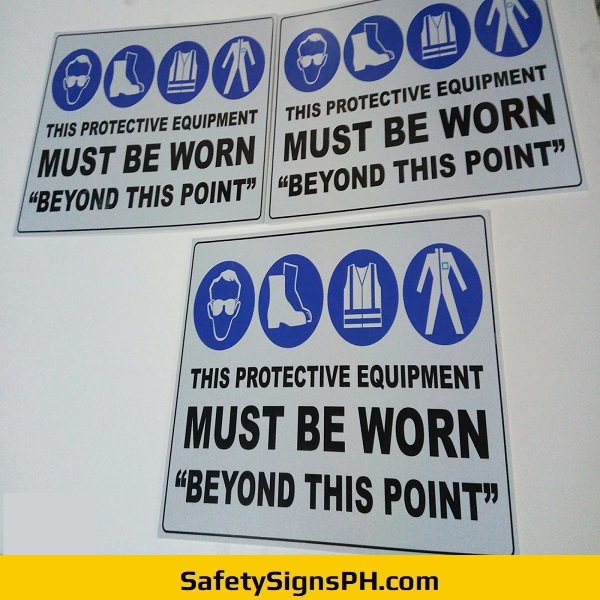The construction industry in the Philippines, booming with infrastructure projects and urbanization, presents unique safety challenges. In this potentially hazardous environment, safety signs act as silent sentinels, conveying crucial information to workers and the public alike.
Understanding the different types of construction safety signs, their meanings, and their proper application is paramount to minimizing accidents, preventing injuries, and fostering a culture of safety on every job site.
1. Prohibition Signs: The "Do Not" Signals
Prohibition signs, easily recognizable by their red circle with a diagonal slash across a symbol, are assertive directives that strictly forbid specific actions. These signs are critical in preventing dangerous behaviors that could lead to immediate harm. Common examples in the Philippines include "No Smoking," "No Entry," "No Open Flames," and "No Unauthorized Access." By clearly outlining prohibited activities, these signs prevent potential hazards like fires, explosions, and unauthorized individuals entering dangerous areas. Their visual impact and direct message leave no room for ambiguity, reinforcing the importance of adhering to safety regulations.
2. Mandatory Signs: The "Must Do" Instructions
Mandatory signs, typically featuring a blue circle with a white symbol, specify actions that are compulsory to ensure safety. These signs dictate essential personal protective equipment (PPE) requirements, such as "Wear Hard Hat," "Wear Safety Glasses," "Wear Safety Boots," and "Use Handrails." They emphasize the personal responsibility of each worker in protecting themselves from workplace hazards. Compliance with mandatory signs is not a suggestion but a requirement enforced to minimize risks associated with falling debris, eye injuries, foot injuries, and falls from heights. By visually prompting workers to utilize the appropriate PPE, these signs contribute significantly to reducing the severity of potential accidents.
3. Warning Signs: The "Be Aware" Alerts
Warning signs, characterized by their yellow triangle with a black border and symbol, alert individuals to potential hazards or dangerous conditions present in the construction area. These signs serve as a cautionary reminder to exercise caution and be vigilant. Common examples include "High Voltage," "Beware of Falling Objects," "Slippery Surface," and "Construction Zone." These signs prompt workers to assess their surroundings, identify potential risks, and take necessary precautions to avoid accidents. They often serve as a general alert to potential dangers that might not be immediately obvious, fostering a heightened sense of awareness on the job site.
4. Information Signs: The "Need to Know" Guides
Information signs, usually rectangular or square with a green background and white text or symbols, provide general information, directions, or instructions relevant to safety. These signs serve as a valuable resource for locating essential facilities and navigating the construction site. Examples include "First Aid Station," "Emergency Exit," "Fire Extinguisher," and "Safety Assembly Point." Clear and accessible information is crucial for ensuring that workers can respond effectively in emergencies and access vital resources when needed. Information signs contribute to a more organized and safer work environment by promoting clear communication and easy access to critical information.
5. Fire Safety Signs: The "Prevent and Respond" Notices
Fire safety signs are specifically designed to highlight fire-related hazards and provide guidance on fire prevention and emergency procedures. They include signs indicating the location of fire extinguishers, fire hydrants, fire alarm pull stations, and fire exits. They may also include signs outlining fire safety procedures, such as "Keep Fire Door Closed" or "No flammable materials." These signs are critical in ensuring a rapid and coordinated response in the event of a fire, minimizing damage and protecting lives.
Conclusion:
The proper implementation and maintenance of these different types of construction safety signs are essential for creating a safer working environment in the Philippines. Regular inspections, employee training on sign recognition and meaning, and consistent enforcement of safety regulations are vital to maximizing their effectiveness. By prioritizing the use of these visual cues, construction companies can significantly reduce the risk of accidents, protect their workforce, and contribute to a more responsible and sustainable construction industry. Furthermore, it's crucial that these signs conform to Philippine standards (such as those outlined by DOLE) to ensure consistency and clear communication across all construction sites. Ultimately, a commitment to safety begins with clear communication, and construction safety signs are a fundamental element of that communication strategy.
Ensure the safety of workers and the public at large with our customized construction safety signs. Don't hesitate to message us today to request a free, no-obligation quotation. We can't wait to hear from you!
Related Product:
|
































No Comments yet. Add your Comments now!
Post a Comment